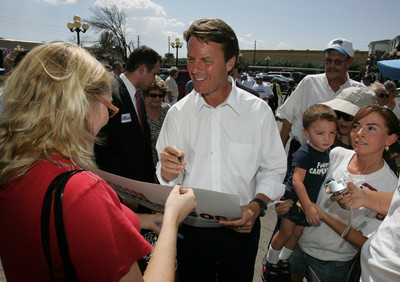Edwards campaign sees hope in Nevada’s first early caucus
Democrat John Edwards' presidential campaign calls Nevada "an unpredictable electorate" but sees hope for the former North Carolina senator in the state's first-time early caucus, according to an internal campaign strategy memo.
The memo, dated Oct. 1 and obtained by the Review-Journal on Wednesday, asserts that Edwards is the most electable candidate for the Democrats in 2008.
In Nevada, it claims Edwards is making progress, noting that in some polling, Edwards and New Mexico Gov. Bill Richardson, who have spent the most time in Nevada, have seen small gains, while support for Hillary Clinton and Barack Obama has not changed substantially.
The document signals that Edwards' campaign, seen as falling behind nationally, still sees a path to winning the nomination -- a path that goes through Nevada. It also provides a glimpse into how the candidates are trying to strategize for a Nevada contest that has no precedent.
"Nevada's new role as an early voting caucus state has challenged pollsters to identify likely voters -- more specifically, caucus goers who will volunteer a significant amount of time to attend a local caucus to support their candidate," the memo by national consulting firm Global Strategy Group notes.
"As a result, there is little data to dissect, but the data that exists is encouraging," it states.
Nevada-specific polling of Democrats who say they will participate in the January caucuses has shown Sen. Clinton, D-N.Y., with a steady, double-digit lead, with Edwards' share of the vote in the low to mid-teens.
Rather than focusing on the numbers, however, the memo looks at movement. In an August poll by the Reno Gazette-Journal, Clinton had 33 percent of Nevada Democrats, Sen. Obama, D-Ill., had 19 percent, Edwards had 15 percent and Richardson had 11 percent.
A poll by the same organization in March had Clinton at 32 percent, Obama 20 percent, Edwards 11 percent and Richardson 2 percent. "John Edwards and Bill Richardson, who not coincidentally have spent the most time in Nevada, saw 4 percent and 9 percent increases respectively," the memo says, while Clinton and Obama "remained flat."
Intervening surveys by other pollsters have not shown a consistent trend upward for Edwards and Richardson, but comparing such polls is difficult since pollsters use different methods. The memo claims, however, that that trend, along with the lack of movement for Clinton and Obama, "is consistent with internal GSG data suggesting voters are still shopping, will break late and will respond when engaged."
The memo argues that Nevada voters will be "enormously impacted by events in Iowa and New Hampshire," the two states expected to vote first. The Nevada caucus, in turn, "will undoubtedly impact the South Carolina and Feb. 5 primaries" that will follow.
In Nevada, Edwards' campaign expects caucus turnout to be "low to moderate" because of its newness. When turnout is low, two groups have disproportionate influence, it argues: "labor and activists ... because they are reliable voters and they are organized."
Edwards has endorsements from unions with 24,000 total members in Nevada, which the memo calls "a clear and decisive edge among labor." Still, the state's biggest and most influential unions, particularly the 60,000-member Culinary, have yet to pick a candidate.
Activists, meanwhile, are drawn to Edwards' "bold policy platform," the memo states. Edwards has tacked to the left of Clinton and Obama, calling for a quicker pullout from Iraq and more government involvement in providing health care, for example.
The memo highlights Edwards' time in the state. "John and Elizabeth Edwards are the most effective advocates for the campaign and combined they have made almost 20 trips to Nevada," it states.
Edwards has spent part or all of 15 days in Nevada. Richardson on Tuesday spent his 16th day in the state. Clinton has spent seven days here, Obama nine.
Clinton's Nevada campaign has snapped up most of the state's notable endorsements from elected officials and other well-known figures, but Edwards is second, and endorsers such as Assemblyman Tick Segerblom, D-Las Vegas, and David Bobzien, D-Reno, have organizing experience, the memo argues.
The biggest story in the Edwards campaign recently has been its decision to accept federal matching funds, a move that could infuse an extra $10 million but that many analysts saw as the last gasp from a desperate organization. The acceptance of public funding also imposes state-by-state spending caps that could impede Edwards.
The memo, however, states, "We have studied the numbers extensively, and we are nowhere near exceeding any state spending limits."
Globally, the memo stakes Edwards' strongest claim for the nomination on the idea of electability. Comparing polls that have pitted Democrats against the top Republican candidates head-to-head, Edwards does slightly better, winning 97 percent of such matchups versus 83 percent for Clinton and 89 percent for Obama.
Representatives of the other major Democratic campaigns dismissed the Edwards campaign's arguments as spin and said they each saw Nevada as winnable for their candidates. Several questioned Edwards' true commitment to Nevada in light of the fact that in August his campaign pulled staff from the state to boost resources in Iowa and New Hampshire.
"Even though we've been ahead in the polls, we never take anything for granted," Clinton spokeswoman Hilarie Grey said. "We have dozens of organizers in all parts of the state."
The Obama campaign has more than 60 staffers in Nevada and will be doubling its offices to six in the coming weeks, said spokeswoman Shannon Gilson. "We're expanding, instead of cutting resources like other campaigns."
The Richardson campaign's "momentum is building" in Nevada, spokesman Josh McNeil said. "Governor Richardson, as the only westerner in the race, is familiar with the issues facing Nevada, and he's spent more time getting to know voters face to face than anyone else," McNeil said.

















